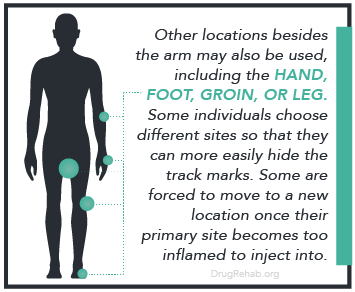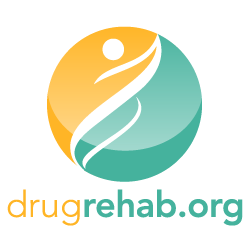
Injection drug abuse is one of the most dangerous ways of administering a drug. Intravenous injection delivers the drug rapidly into your system, creating what is nearly an immediate and very intense high. Because of this, it’s the most popular way to inject a drug.
What Is Intravenous (IV) Drug Use?
Injection drug use means simply that the drug is administered through a needle or syringe. It doesn’t always mean that the drug is injected into your vein. Some users choose to inject the drug into their muscle or just below their skin, whereas others shoot it directly into their bloodstream. The latter method is referred to as intravenous or IV drug use.
 The most frequently used veins are those in the crook of the forearm, though other locations may be used. If a person injects into their arm, it’s typically the one opposite from the hand they write with. This makes it easier for them to inject the drug themselves. To work around this, some people may have a fellow drug abuser inject the substance for them into their dominant arm.
The most frequently used veins are those in the crook of the forearm, though other locations may be used. If a person injects into their arm, it’s typically the one opposite from the hand they write with. This makes it easier for them to inject the drug themselves. To work around this, some people may have a fellow drug abuser inject the substance for them into their dominant arm.
There are other locations which may also be used, including the hand, foot, groin, or leg. Some individuals choose different sites so that they can more easily hide the track marks. Others may be forced to move to a new location once their primary site becomes too inflamed or scarred to continue injecting in.
Once the drug of choice is loaded into the syringe, the user selects a vein for entry. Now they “tie off” near the location for injection. To do this, a belt, rubber tubing, or other strap-like item is tied tightly around their arm. This is called a tourniquet or “tie.” This causes the vein to swell, making it easier to inject the needle into. As soon as the needle is in the vein, the tourniquet is removed. Failure to do so can cause even more complications.
What Types Of Drugs Are Injected?
Many drugs of abuse can be administered more than one way, including by IV injection. Commonly injected drugs include:
- Cocaine (including crack)
- Heroin
- Ketamine
- Methamphetamine
- Morphine
- Opioid painkillers
- PCP
- Prescription stimulants
Some, like cocaine and heroin, are frequently abused together. This is called a speedball. Across the US, there are increasing reports of potent opioids being mixed with cocaine and heroin. Injecting any of these drugs, either alone or in combination, is very dangerous and can lead to a fatal outcome.
Are you or a loved one suffering from addiction?
Don't wait, get the best treatment options today
Call Now: (833) 473-4227What Causes Track Marks?
Track marks are the scars which remain after a person shoots up a drug. These marks are caused by:
Chronic Abuse: Prolonged and repeated use at the same injection site increases the odds of a track mark developing. Over time, as a person continuously injects in the same spot, the vein becomes damaged and scars build up.

Old Needles: If a person keeps on using the same needle, the tip will become blunted and dull. Upon injection, this places excess pressure on the vein and damages it even more.
Impure Drugs: It’s very rare to find a pure drug on the street. Instead, the majority of illicit drugs have some form of contamination. These impurities may result from poor manufacturing processes or because the drug was purposely adulterated or “cut” with other substances. The build up of these toxins is often responsible for the darker color of the track mark.
What Do Track Marks Look Like?
Track marks are often the most tell-tale signs that a person is an IV drug abuser. Technically speaking, as we’ve explained, a track mark is a scar. However, due to the fact that many IV drug users engage in chronic substance abuse, the appearance of these marks may vary. Track marks look different depending on what stage of healing they’re in. What this means is that some people may have fresh marks layered upon or alongside of older scars.
Recent marks: These lesions may look fresh, having not yet had time to heal. Shortly after injection, they may appear as puncture marks, scabs, or bruises.
Older marks: As drug use progresses, the skin may crack, bleed, and even become infected. Track marks and scarring run the length of the vein and appear slightly raised and discolored (darker) in comparison to the rest of the skin.
Drug abusers often try to hide these marks by wearing long sleeves (even in warm weather) or even by getting tattoos over the injection site.
Track marks don’t necessarily go away once you’ve stopped abusing drugs. Medscape cites a study which found that 53 percent of former IV drug abusers had visible scars after five years. This isn’t the only serious concern associated with IV drug injection.
Are There Other Dangers Of IV Drug Use?
Track marks are only one type of damage which can occur to a person’s skin, tissues, and organs from IV drug use. Additionally, a person could also develop:
- Abscesses
- Bacterial, fungal, and/or viral infections
- Cardiac complications
- Cellulitis
- Collapsed veins
- Deep vein thrombosis (blood clots form in your veins)
- Necrotizing fasciitis “flesh eating disease”
- Organ damage
 Injection drug users face increased risk of blood-borne infectious diseases, such as HIV/AIDS and Hepatitis B and C.
Injection drug users face increased risk of blood-borne infectious diseases, such as HIV/AIDS and Hepatitis B and C.
Intravenous drug abuse requires intensive treatment. Due to the number of serious medical complications associated with IV abuse, many users need comprehensive medical care prior to, and during, treatment. Any underlying infections or diseases must be properly cared for. Wound care, antibiotics, and/or other medications or procedures may be administered to facilitate healing. Once any acute complications are addressed and a person is stabilized, they may then continue to drug addiction treatment.
How To Overcome IV Drug Addiction
Certain drugs, like heroin and prescription opioids, typically require detoxification prior to treatment. Many inpatient drug rehabs offer detox services at their facilities. After detox is completed, a person progresses into the treatment program.
These programs utilize counseling, behavioral therapies, and a wide variety of other modalities to treat the root of a person’s addiction. In order to combat the temptation of future drug use, relapse prevention techniques will also be taught. Combined, these elements work towards preparing you or your loved one for a more stable and healthy drug-free life.
Protect Your Body And Mind
Drug abuse and addiction don’t have to rule your life. The right treatment can help you regain control over your life and health. DrugRehab.org can help you to begin building a drug-free life, so that you can achieve these goals. Our caring staff can help you find the treatment program which is best for your unique needs. Contact us now.


